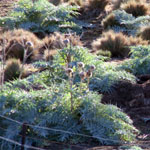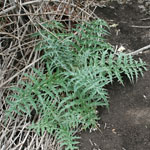Artichoke thistle
Artichoke thistle is a perennial herb with blue to purple flowers.
Common name:
- Artichoke thistle
Scientific name:
- Cynara cardunculus L.
Other common names:
- Wild Artichoke, Cardoon
Plant status
Catchment management authority boundaries
Regionally prohibited in the Goulburn Broken, North East and West Gippsland catchments
Regionally controlled in the Mallee, North Central, Corangamite, Port Phillip and Westernport catchments
Restricted in the Wimmera, Glenelg Hopkins and East Gippsland catchments
Plant biology

Appearance
Herbaceous plant — Forb (flowering herbaceous plant — not a grass).
Description
Artichoke thistle is a perennial herb.
Stems
Stems are greyish-green. Mature plant stems are strongly ribbed, covered in cottony down on the underneath and branched near the top.
Generally, only 1 stem develops from each crown but up to 8 may be produced.
Leaves
Leaves are greyish-green on the upper surface and covered with a dense mat of white hair underneath.

Artichoke thistle forms a basal rosette of leaves which can grow out (horizontally) to 1m in length and 30cm wide and sends up a stalk in the centre (or stem leaf) which is smaller, about 15cm long.
All leaves are deeply divided containing a sharp yellow-orange spine along the margins.
Flowers
Florets are blue to purple with globular-shaped heads of 7 to 13cm diameter. These are surrounded by a series of stout bracts, each ending in a spiny tip.
Fruit
No fruit.
Seeds
Bears no fruit but seeds range from brown to black, 6 to 8mm long and are streaked lengthwise. They are equipped with a pappus of feathery hairs up to 4cm long that acts as a parachute to aid dispersal.

Growth and lifecycle
Method of reproduction and dispersal
Seeds from the plant are generally dispersed by wind, with most seeds only dropping a few metres from the parent plant. However, some seeds can travel up to 20 metres from the plant.
Seeds can also be spread by livestock, birds and flood.
Careless disposal of cut flowers and fragments of roots can also lead to the germination of new plants in favourable conditions. Soil movement may assist the spread of this plant.
Rate of growth and spread
The seedlings of the Artichoke thistle germinate year round but predominantly after the autumn rains.
Growth slows during winter becoming rapid during spring.
Plants may flower in the first year of growth but is generally delayed until the second summer.
Seedbank propagule persistence
Most Artichoke thistle seeds can survive up to five years in the soil.
Origin
Native of the Mediterranean.
Preferred habitat
Artichoke thistle prefers poorer pastures and neglected areas such as roadsides, creek and river frontages, industrial areas and waste lands. It grows mainly in medium to heavy soils and in areas where rainfall is between 500 to 700mm annually.
Distribution
There are many heavy infestations of this weed in Victoria.
Growth calendar
The icons on the following table represent the times of year for flowering, seeding, germination, the dormancy period of Artichoke thistle and also the optimum time for treatment.
| Jan | Feb | Mar | Apr | May | Jun | Jul | Aug | Sep | Oct | Nov | Dec | |
|---|---|---|---|---|---|---|---|---|---|---|---|---|
| Flowering |  |  |  | |||||||||
| Seeding |  |  |  | |||||||||
| Germination |  |  |  | |||||||||
Dormancy | ||||||||||||
| Treatment |  |  |  |
Impact
Impact on ecosystems and waterways
Artichoke thistle displaces and impacts on native grasslands.
Some small birds feed on the seeds of the artichoke thistle and are responsible for increasing the spread along plantations, watercourses and fence lines.
Agricultural and economic impacts
Artichoke thistle has its greatest impact on agricultural land.
Once established, the weed shades out most pasture species as well as drawing moisture and nutrients from the soil.
The spiny nature of the plant deters sheep and cattle from grazing near heavy infestations. However, the plant will be eaten by livestock if no other food is available.
Social value and health impacts
The plant is reported to cause contact dermatitis in some people.
Management
Prescribed measures for the control of noxious weeds:
- application of a registered herbicide
- physical removal.
Read about prescribed measures for the control of noxious weeds.
Other management techniques
Changes in land use practices and spread prevention may also support Artichoke thistle management after implementing the prescribed measures above.